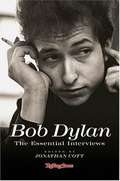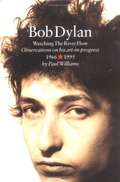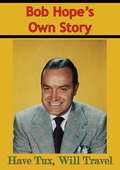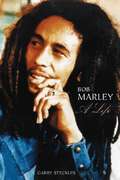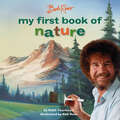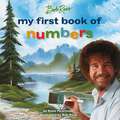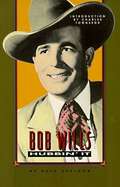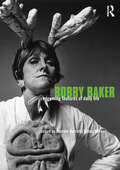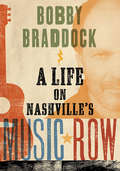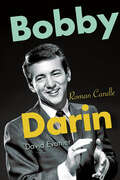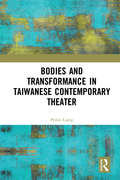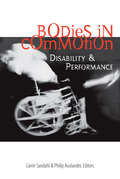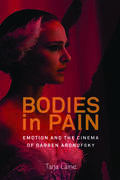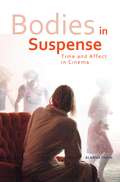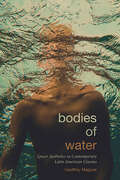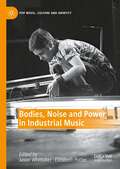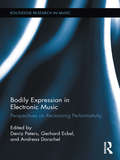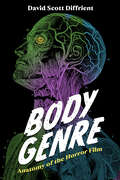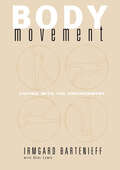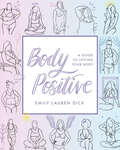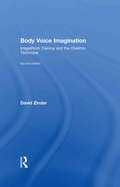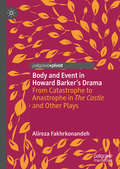- Table View
- List View
Bob Dylan: The Essential Interviews
by Jonathan CottThirty-one of the most significant and revealing conversations with Dylan have been compiled in this volume. Among the highlights are the seminal "Rolling Stone" interviews by Jann Wenner, Jonathan Cott, Kurt Loder, and Mikal Gilmore.
Bob Dylan: Watching the River Flow, Observations on His Art-in-Progress, 1966+1995
by Paul WilliamsWatching The River Flow is an outstanding collection of Dylan-related essays by Paul Williams, the noted US editor and critic, opening with his 1966 review of Blonde On Blonde and closing with his observations about Dylan's 1995 tour with Patti Smith. The author of over 20 books, including the two highly acclaimed volumes of Dylan criticism, Performing Artist 1960-73 and Performing Artist 1974-86, no American writer has followed Dylan more closely, nor written about his work with more insight.
Bob Hope’s Own Story - Have Tux, Will Travel: Bob Hope's Own Story
by Bob Hope Pete Martin"If I had my life to live over again, I wouldn't have time." -- Bob HopeThe legendary wit and unmistakable voice of America's favorite showman are captured here in the master entertainer's memoir of his first fifty years in show business.From his one-night stands in vaudeville to countless performances for servicemen on U.S. military bases across the globe, this delightfully candid book of funny life stories is pure Hope. In his own words, Hope recalls his brief career as an amateur prizefighter; his flops and successes in vaudeville; memories of sharing the stage with Ethel Merman and Jimmy Durante; his courtship of the young singer who would become his bride; his forgettable first screen test; his friendship with Bing Crosby and their high jinks on the sets of the famous Road pictures; poignant and hair-raising trips to entertain the troops; a personal request from General Patton; and eighteen holes of golf with President Eisenhower.Bob Hope was the unchallenged king of the one-liner, a consummate performer, and a beloved supporter of our men in uniform, and his irrepressible spirit shines through in these hilarious, nostalgic, and truly memorable stories from a life lived to bring laughter to others.-Print ed.
Bob Marley: A Life
by Garry StecklesThis biography on reggae legend Bob Marley reflects the growing popularity and legacy that continues to grow more than 27 years after the singer's death from cancer at age 36. Steckles has been writing about the reggae music scene for many years, and he was granted access to an enormous archive of material to produce the most vivid and detailed account of Marley's life to date, concentrating on his Rastafarian faith, devotion to marijuana, turbulent family life and his global influence on World Music.
Bob Ross' Happy Little Night Before Christmas
by Robb Pearlman2022 IPPY AWARDS SILVER MEDALIST - HOLIDAY &“[A] breathtaking family treasure to page through, highly recommended.&” —Midwest Book Review An instant holiday classic. A happy little Christmas miracle. Even after more than 20 years after his death, pop culture icon, painter, host, and teacher Bob Ross has never been more heralded than he is today. His memorable quotes, friendly face, and signature hairstyle grace merchandise and memes around the world. But what makes Bob as beloved as he is are ultimately his core values, and his peaceful, joyful demeanor that encouraged his students and viewers to not only appreciate their natural talents but to appreciate the natural world around them. Bob was, in many respects, the embodiment of the classic holiday sprint which encourages peace on Earth and good will toward men. Now, for the first time, inspired by the classic Clement C. Moore&’s story, this fully-authorized tale of a painter (and his little squirrel friend) on a cold winter night pairs Bob Ross's most beautiful wintertime landscapes with a meditation on embracing not only your inner creativity, but the beauty of nature, and the feelings of peace, friendship, and harmony that blankets the entire holiday season like a happy little snowfall. Perfect for families, fans, and painters of all ages, Bob Ross&’s Happy Little Night Before Christmas is the perfect addition to any holiday tradition.
Bob Ross: My First Book of Colors
by Robb PearlmanA titanium snowcapped mountain. A happy little tree made with Van Dyke Brown and Dark Sienna. A majestic, vibrant phthalo blue sky. Bob Ross: My First Book of Colors is an early concept board book featuring various Bob Ross paintings and some of Bob's little quips about each of the thirteen colors he used on his palette in front of TV audiences. Full of real paintings from the iconic artist, this is sure to be a hit for any Bob Ross fan.Colors include: Alizarin Crimson Bright Red Cadmium Yellow Hue Dark Sienna Indian Yellow Midnight Black Phthalo Blue Prussian Blue Sap Green Titanium White Van Dyke Brown Yellow Ochre
Bob Ross: My First Book of Nature (My First Bob Ross Books)
by Robb PearlmanThe second official board book featuring Bob Ross's stunning, iconic paintings with a special nod to the natural world.Happy little clouds. Tall, snow-capped mountains. River rocks. The beauty of nature is everywhere. Bob Ross: My First Book of Nature is an early concept board book featuring various Bob Ross paintings and some of Bob's little quips about all of the beautiful sights seen in nature and that he painted in front of TV audiences. Full of real paintings from the iconic artist, this follow up to Bob Ross: My First Book of Colors is sure to be a hit for any Bob Ross fan.
Bob Ross: My First Book of Numbers (My First Bob Ross Books)
by Robb PearlmanToddlers will learn their numbers and basic counting skills with Bob Ross and his 13 paints in this early concept board book. Count your way to thirteen in this serene and peaceful early concept board book in the Bob Ross My First Book series, which includes Bob Ross: My First Book of Colors and Bob Ross: My First Book of Nature! Count one bright moon, two friends, three (then four) trees, five rocks, and more with iconic painter Bob Ross as he quips and reminds you to take things slowly. Illustrated using real paintings created by Bob Ross, this is a perfect board book for fans young and old alike! Copyright © 2023 by Bob Ross Inc. ®Bob Ross name and images are registered trademarks of Bob Ross Inc. © Bob Ross Inc. Used with Permission. All rights reserved.
Bob Wills: Hubbin' It
by Charles R. Townsend Ruth SheldonUnavailable for decades, this pioneering biography of the King of Western Swing returns to print in a handsome new edition with index and a new critical introduction. Few figures in country music's history have left as distinctive and lasting an impression as Bob Wills (1905-1975). An expert fiddler and a magnetic showman, Wills popularized a style of Southwestern dance music known as western swing, a rhythmic hybrid of Texas fiddle music, blues, and big band swing that set dance halls alight across the Southwest in the thirties and forties. Despite his passing, his legacy has been carried forward in the music of such modern stars as Merle Haggard and George Strait. In 1938, when Wills was thirty-three and nearing the height of his fame, journalist Ruth Sheldon chronicled the rags-to-riches rise of this talented musician, showing remarkable foresight in her choice of subject. Working with the complete cooperation of Wills, Sheldon produced a biography that fully captures the ebullient personality of Wills and reflects the bandleader's vision of himself. Noted country music historian Bill C. Malone has praised this book as a "pioneering biography," a landmark in the recording of country music history. Now restored to print for the first time since its initial 1938 publication, Hubbin' It provides a fascinating window into the daily life of a working musician during the Depression. It is a rich source of historical detail on the life of one of America's great musical innovators. Distributed for the Country Music Foundation Press.
Bobby Baker: Redeeming Features of Daily Life
by Michèle Barrett Bobby BakerBobby Baker is one of most widely acclaimed and popular performance artists working today. Over the course of a thirty-five-year career she has toured the globe with her wildly stimulating explorations of 'Daily Life' and has been extensively written about and studied. This fully-illustrated book brings together for the first time an account of Baker's career as an artist – from her first sculptures at Central St Martins in the early 1970s to her most recent work, 'How to Live' and 'Diary Drawings' – with critical commentary by reviewers and academic practitioners. It includes: Bobby Baker's own 'Chronicle' of her work as artist and performer illuminating critical writing about Baker's shows transcripts of Baker's performances and other original materials reproduced here for the first time significant new essays by Michele Barrett and Griselda Pollock a new interview with Bobby Baker by Adrian Heathfield. Under the guiding editorial hand of distinguished cultural theorist Michèle Barrett, this volume is an essential text for students interested in performance, gender, and visual culture, and a hugely absorbing and accessible account of Baker's work.
Bobby Braddock: A Life on Nashville's Music Row (Co-published with the Country Music Foundation Press)
by Bobby BraddockIf you know country music, you know Bobby Braddock. Even if you don't know his name, you know the man's work. "He Stopped Loving Her Today." "D-I-V-O-R-C-E." "Golden Ring." "Time Marches On." "I Wanna Talk About Me." "People Are Crazy." These songs and numerous other chart-topping hits sprang from the mind of Bobby Braddock. A working songwriter and musician, Braddock has prowled the streets of Nashville's legendary Music Row since the mid-1960s, plying his trade and selling his songs. These decades of writing songs for legendary singers like George Jones, Tammy Wynette, and Toby Keith are recounted in Bobby Braddock: A Life on Nashville's Music Row, providing the reader with a stunning look at the beating heart of Nashville country music that cannot be matched. If you're looking for insight into Nashville, the life of music in this town, and the story of a force of nature on the Row to this day, Bobby Braddock will take you there.
Bobby Braddock: A Life on Nashville’s Music Row (Co-published with the Country Music Foundation Press)
by Bobby BraddockIf you know country music, you know Bobby Braddock. Even if you don't know his name, you know the man's work. "He Stopped Loving Her Today." "D-I-V-O-R-C-E." "Golden Ring." "Time Marches On." "I Wanna Talk About Me." "People Are Crazy." These songs and numerous other chart-topping hits sprang from the mind of Bobby Braddock. A working songwriter and musician, Braddock has prowled the streets of Nashville's legendary Music Row since the mid-1960s, plying his trade and selling his songs. These decades of writing songs for legendary singers like George Jones, Tammy Wynette, and Toby Keith are recounted in Bobby Braddock: A Life on Nashville's Music Row, providing the reader with a stunning look at the beating heart of Nashville country music that cannot be matched.If you're looking for insight into Nashville, the life of music in this town, and the story of a force of nature on the Row to this day, Bobby Braddock will take you there.
Bobby Darin: Roman Candle (Excelsior Editions)
by David EvanierA multilayered portrait of this brash, gifted artist, whose restless voice and spirit seem as alive today as ever.A performer who rivaled Sinatra, Bobby Darin rose from dire poverty to become one of the biggest stars of his generation. Dogged by chronic illness, he knew that time was not on his side, and so, in a career full of dizzying twists and turns, he did it all, moving from teen idol to Vegas song-and-dance man, from hipster to folkie and back. In this biography, David Evanier offers a multilayered portrait of this brash, gifted artist, including the dark side of his celebrated marriage to America's sweetheart, Sandra Dee, and the incredible family secret that tore him apart at the end.
Bodies and Transformance in Taiwanese Contemporary Theater
by Peilin LiangIn Bodies and Transformance in Taiwanese Contemporary Theater, Peilin Liang develops a theory of bodily transformation. Proposing the concept of transformance, a conscious and rigorous process of self-cultivation toward a reconceptualized body, Liang shows how theater practitioners of minoritized cultures adopt transformance as a strategy to counteract the embodied practices of ideological and economic hegemony. This book observes key Taiwanese contemporary theater practitioners at work in forging five reconceptualized bodies: the energized, the rhythmic, the ritualized, the joyous, and the (re)productive. By focusing on the development of transformance between the years of 2000–2008, a tumultuous political watershed in Taiwan’s history, the author succeeds in bridging postcolonialism and interculturalism in her conceptual framework. Ideal for scholars of Asian and postcolonial theater, Bodies and Transformance in Taiwanese Contemporary Theater shows how transformance, rather than performance, calibrates with far greater precision and acuity the state of the body and the culture that it seeks to create.
Bodies in Commotion: Disability and Performance
by Carrie Sandahl Philip Auslander"A testament to the synergy of two evolving fields. From the study of staged performances to examinations of the performing body in everyday life, this book demonstrates the enormous profitability of moving beyond disability as metaphor. . . . It's a lesson that many of our cultural institutions desperately need to learn. " -Martin F. Norden, University of Massachusetts-Amherst This groundbreaking collection imagines disabled bodies as "bodies in commotion"-bodies that dance across artistic and discursive boundaries, challenging our understanding of both disability and performance. In the book's essays, leading critics and artists explore topics that range from theater and dance to multi-media performance art, agit-prop, American Sign Language theater, and wheelchair sports. Bodies in Commotionis the first collection to consider the mutually interpretive qualities of these two emerging fields, producing a dynamic new resource for artists, activists, and scholars.
Bodies in Pain: Emotion and the Cinema of Darren Aronofsky
by Tarja LaineThe films of Darren Aronofsky invite emotional engagement by means of affective resonance between the film and the spectator’s lived body. Aronofsky’s films, which include a rich range of production from Requiem for a Dream to Black Swan, are often considered “cerebral” because they explore topics like mathematics, madness, hallucinations, obsessions, social anxiety, addiction, psychosis, schizophrenia, and neuroscience. Yet this interest in intelligence and mental processes is deeply embedded in the operations of the body, shared with the spectator by means of a distinctively corporeal audiovisual style. Bodies in Pain looks at how Aronofsky’s films engage the spectator in an affective form of viewing that involves all the senses, ultimately engendering a process of (self) reflection through their emotional dynamics.
Bodies in Suspense: Time and Affect in Cinema
by Alanna ThainBodies in Suspense presents a powerful new way to think through postdigital cinema and the affective turn in critical theory. According to Alanna Thain, suspense films allow us to experience the relation between two bodies: that of the film and that of the viewer. Through the &“time machine&” of suspense, film form, gender, genre, and spectatorship are revealed in innovative and different ways. These films not only engage us directly in ethical concerns, but also provide a key for understanding corporeal power in the digital era. Offering a new framework for understanding cinematic suspense, Bodies in Suspense argues that the &“body in time&” enables us to experience the temporal dimension of the body directly. This is the first book to link two contemporary frames of analysis: questions of cinematic temporality and contemporary affect theory. Thain conducts close readings of influential suspense films by Alfred Hitchcock, David Lynch, Christian Marclay, Rian Johnson, and Lou Ye, and sets forth a compelling new theory of cinema, reading for the productivity of the &“crime of time&” that stages the duplicity of cinematic bodies. Through these films that foreground doubled characters and looping, Thain explores Gilles Deleuze&’s claim that &“the direct time-image is the phantom which has always haunted cinema.&”A vital new addition to film theory, corporeality and affect theory, feminist theory, and the philosophy of time—and one of the first books to explore David Lynch&’s Hollywood trilogy—Bodies in Suspense asks us to pay attention, above all, to the ways in which the condition of spectatorship creates a doubling sensation with important philosophical repercussions.
Bodies of Water: Queer Aesthetics in Contemporary Latin American Cinema (SUNY series in Latin American Cinema)
by Geoffrey MaguireRivers, swimming pools, lakes, and oceans: these watery spaces recur with remarkable frequency in recent queer Latin American cinema, urging us to question the intimacies between queerness and the aquatic. Unpredictable and uncontrollable, water reflects a natural fluidity in our sexual desires and orientations; it is both a space and a substance, one in which bodies surrender themselves to the natural forces of currents and flows. As the first book to investigate water's queer cinematic potential, Bodies of Water proposes that we think not only about water but also through it, illuminating new directions for the study of queer world cinema and its evolving aesthetic strategies. Bodies of Water engages critically with theories of cinematic embodiment and recent work in queer theory and the environmental humanities, foregrounding a region of the world historically overlooked in global discussions of queerness. By examining the radical queer epistemologies that emerge at the convergence of body, camera, and water, Bodies of Water ultimately poses a question of both critical and sociopolitical concern: what's so queer about cinematic waters?
Bodies, Noise and Power in Industrial Music (Pop Music, Culture and Identity)
by Jason Whittaker Elizabeth PotterThis edited collection delves into the industrial music genre, exploring the importance of music in (sub)cultural identity formation, and the impact of technology on the production of music. With its roots as early as the 1970s, industrial music emerged as a harsh, transgressive, and radically charged genre. The soundscape of the industrial is intense and powerful, adorned with taboo images, and thematically concerned with authority and control. Elemental to the genre is critical engagement with configurations of the body and related power. Adopting an interdisciplinary approach, this collection analyses the treatment of subjects like the Body (animal, human, machine), Noise (rhythmic, harsh) and Power (authority, institutions, law) in a variety of industrial music’s elements. Throughout the collection, these three subjects are interrogated by examining lyrics, aesthetics, music videos, song writing, performance and audience reception. The chapters have been carefully selected to produce a diverse and intersectional perspective, including work on Black industrial musicians and Arabic and North African women’s collaborations. Rather than providing historical context, the contributors interpret the finer elements of the aesthetics and discourses around physical bodies and power as expressed in the genre, expanding the ‘industrial’ boundary and broadening the focus beyond white European industrial music.
Bodily Expression in Electronic Music: Perspectives on Reclaiming Performativity (Routledge Research in Music)
by Deniz Peters Gerhard Eckel Andreas DorschelIn this book, scholars and artists explore the relation between electronic music and bodily expression from perspectives including aesthetics, philosophy of mind, phenomenology, dance and interactive performance arts, sociology, computer music and sonic arts, and music theory, transgressing disciplinary boundaries and established beliefs. The historic decoupling of action and sound generation might be seen to have distorted or even effaced the expressive body, with the retention of performance qualities via recoupling not equally retaining bodily expressivity. When, where, and what is the body expressed in electronic music then? The authors of this book reveal composers’, performers’, improvisers’ and listeners’ bodies, as well as the works’ and technologies’ figurative bodies as a rich source of expressive articulation. Bringing together humanities’ scholarship and musical arts contingent upon new media, the contributors offer inspiring thought and critical reflection for all those seriously engaged with the aesthetics of electronic music, interactive performance, and the body’s role in aesthetic experience and expression. Performativity is not only seen as being reclaimed in live electronic music, interactive arts, and installations; it is also exposed as embodied in the music and the listeners themselves.
Body Genre: Anatomy of the Horror Film (Horror and Monstrosity Studies Series)
by David Scott DiffrientIn this groundbreaking work, author David Scott Diffrient explores largely understudied facets of cinematic horror, from the various odors permeating classic and contemporary films to the wetness, sliminess, and stickiness of these productions, which, he argues, practically scream out for a tactile mode of textural analysis as much as they call for more traditional forms of textual analysis. Dating back to Carol Clover’s and Linda Williams’s pioneering work on horror cinema, film scholars have long conceptualized this once-disreputable category of cultural production as a “body genre.” However, despite the growing recognition that horror serves important biological and social functions in our lives, scholars have only scratched the surface of this genre with regard to its affective, corporeal, and sensorial appeals.Diffrient anatomizes horror films in much the same way that a mad scientist might handle the body, separating and recombining constitutive parts into a new analytical whole. Further, he challenges the tendency of scholars to privilege human over nonhuman beings and calls into question ableist assumptions about the centrality to horror films of sight and sound to the near exclusion of other forms of sense experience. In addition to examining the role that animals—living or dead, real or fake—play in human-centered fictions, this volume asks what it means for audiences to consume motion pictures in which actors, stunt performers, and other creative personnel have put their own bodies and lives at risk for our amusement. Historically grounded and theoretically expansive, Body Genre: Anatomy of the Horror Film moves the study of cinematic horror into previously unchartered waters and breathes life into a subject that, not coincidentally, is intimately connected to breathing as our most cherished dividing line between life and death.
Body Movement: Coping with the Environment
by Irmgard Bartenieff Dori Lewis"'Irmgard Bartenieff has a profound knowledge of the human body and how it moves. I am delighted that this will now be made available to many more people.'." -- George Balanchine of Director, New York City Ballet"'Irmgard Bartenieff's pioneering work in the multiple applications of Labananalysis has had a transforming influence on many areas of movement training. Her careful and detailed development of the spatial principles into active corrective work has illuminated and altered the training of people as varied as dancers, choreographers, physical therapists, movement and dance therapists, and psychotherapists. Anthropologists and non-verbal communication researchers have found their world view necessarily altered by her fundamental innovations. The field of body/mind work will need to adapt to include her clear working through of basic principles.'." -- Kayla Kazahn Zalk of President, American Dance Guild
Body Positive: A Guide to Loving Your Body
by Emily Lauren DickPacked with introspective questions and gorgeous, un-retouched photographs that display the bodies of real, everyday women aimed at teaching young women that every body is beautiful and happiness comes in all shapes and sizes. A Foreword Reviews recommended title for Mental Health Awareness Month
Body Voice Imagination: ImageWork Training and the Chekhov Technique (A\theatre Arts Book Ser.)
by David ZinderFirst published in 2008. Routledge is an imprint of Taylor & Francis, an informa company.
Body and Event in Howard Barker's Drama: From Catastrophe to Anastrophe in The Castle and Other Plays
by Alireza FakhrkonandehThis book explores questions of gender, desire, embodiment, and language in Barker’s oeuvre. With The Castle as a focal point, the scope extends considerably beyond this play to incorporate analysis and exploration of the Theatre of Catastrophe; questions of gender, subjectivity and desire; God/religion; aesthetics of the self; autonomy-heteronomy; ethics; and the relation between political and libidinal economy, at stake in 20 other plays by Barker (including Rome, The Power of the Dog, The Bite of the Night, Judith, Possibilities, I Saw Myself, Fence in Its Thousandth Year, The Gaoler’s Ache for the Nearly Dead, The Brilliance of the Servant, Golgo, among others).
